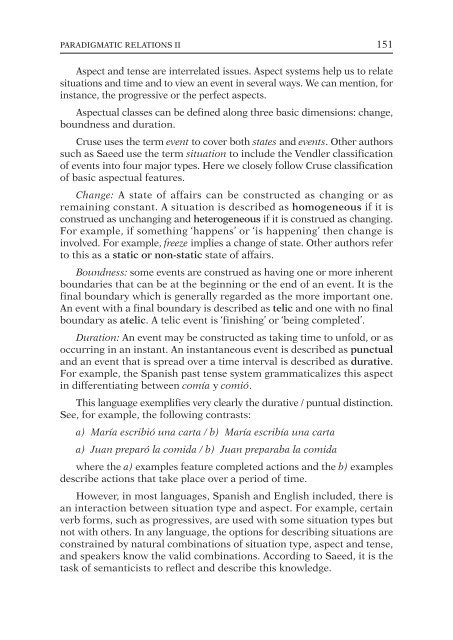Semantics
You also want an ePaper? Increase the reach of your titles
YUMPU automatically turns print PDFs into web optimized ePapers that Google loves.
PARADIGMATIC RELATIONS II 151<br />
Aspect and tense are interrelated issues. Aspect systems help us to relate<br />
situations and time and to view an event in several ways. We can mention, for<br />
instance, the progressive or the perfect aspects.<br />
Aspectual classes can be defined along three basic dimensions: change,<br />
boundness and duration.<br />
Cruse uses the term event to cover both states and events. Other authors<br />
such as Saeed use the term situation to include the Vendler classification<br />
of events into four major types. Here we closely follow Cruse classification<br />
of basic aspectual features.<br />
Change: A state of affairs can be constructed as changing or as<br />
remaining constant. A situation is described as homogeneous if it is<br />
construed as unchanging and heterogeneous if it is construed as changing.<br />
For example, if something ‘happens’ or ‘is happening’ then change is<br />
involved. For example, freeze implies a change of state. Other authors refer<br />
to this as a static or non-static state of affairs.<br />
Boundness: some events are construed as having one or more inherent<br />
boundaries that can be at the beginning or the end of an event. It is the<br />
final boundary which is generally regarded as the more important one.<br />
An event with a final boundary is described as telic and one with no final<br />
boundary as atelic. A telic event is ‘finishing’ or ‘being completed’.<br />
Duration: An event may be constructed as taking time to unfold, or as<br />
occurring in an instant. An instantaneous event is described as punctual<br />
and an event that is spread over a time interval is described as durative.<br />
For example, the Spanish past tense system grammaticalizes this aspect<br />
in differentiating between comía y comió.<br />
This language exemplifies very clearly the durative / puntual distinction.<br />
See, for example, the following contrasts:<br />
a) María escribió una carta / b) María escribía una carta<br />
a) Juan preparó la comida / b) Juan preparaba la comida<br />
where the a) examples feature completed actions and the b) examples<br />
describe actions that take place over a period of time.<br />
However, in most languages, Spanish and English included, there is<br />
an interaction between situation type and aspect. For example, certain<br />
verb forms, such as progressives, are used with some situation types but<br />
not with others. In any language, the options for describing situations are<br />
constrained by natural combinations of situation type, aspect and tense,<br />
and speakers know the valid combinations. According to Saeed, it is the<br />
task of semanticists to reflect and describe this knowledge.



